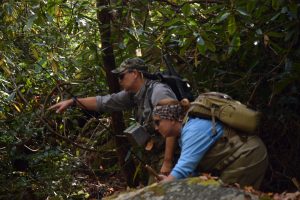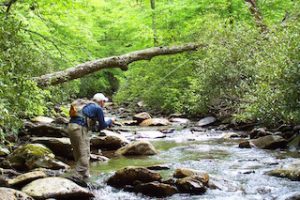 As many of you know, I spend nearly 200 days a year fishing and guiding on small mountain streams in the Smoky Mountains where creel surveys indicate that approximately 90% of (unguided) fishermen never catch a fish. Meanwhile, the 10% who do catch fish tend to catch A LOT of them. When fishing small streams, it’s a fine line between getting skunked and catching 50, and most of the time, the difference isn’t what’s in your fly box. In the Smokies and other similar small mountain streams, approach and presentation is the name of the game and to have success, you may need to adjust a few of your techniques. Listed below are 10 tips that may make your next small stream fishing trip more productive.
As many of you know, I spend nearly 200 days a year fishing and guiding on small mountain streams in the Smoky Mountains where creel surveys indicate that approximately 90% of (unguided) fishermen never catch a fish. Meanwhile, the 10% who do catch fish tend to catch A LOT of them. When fishing small streams, it’s a fine line between getting skunked and catching 50, and most of the time, the difference isn’t what’s in your fly box. In the Smokies and other similar small mountain streams, approach and presentation is the name of the game and to have success, you may need to adjust a few of your techniques. Listed below are 10 tips that may make your next small stream fishing trip more productive.
Dress for Success: As simple as it sounds, one of the biggest keys to being successful is not spooking the fish. There are a number of ways you can spook a trout but it all starts with what you wear. Leave the coral casting shirts at home. Instead, dress in earth tones like olive, tan, and grey. You don’t need to be a fly fishing commando with face paint and twigs in your hat but you do need to blend in.
This doesn’t matter as much on big, open rivers because you’re usually casting farther and your backdrop is the sky. On small mountain streams, you’re closer to the fish and your backdrop is usually trees, bushes, and rocks. Brighter colors stand out against that backdrop and allow the trout to more easily detect your movement.
Wade Quietly: Think Great Blue Heron and not Labrador Retriever when you’re moving through the stream. Step slowly, quietly, and try not to drag your legs through the water. Again, you’re closer to the fish in these streams and the fish are going to be sensitive to splashes and rocks scraping together. For this same reason, I don’t encourage wearing studded wading boots on these streams.
Move Upstream: Trout are going to be facing upstream watching a current for food. By moving upstream, you will be staying behind the fish making it more difficult for it to detect you.

Stay Low: A trout has a cone of vision that allows it to see things above it. The closer and higher up you are, the more the fish will be able to visually detect your movements. As before, you don’t have to be a fly fishing commando and belly crawl from spot to spot. Just try to crouch more when approaching a run and take advantage of natural barriers. For example, if there’s a boulder in the water, stay behind it rather than standing on it.
Read the Water: Trout won’t be just anywhere in the stream. Aimlessly casting your fly around the creek is not only unproductive, you risk spooking the good spots by throwing your line across them. Most of what you’ll find in small mountain streams is pocket water, which is just faster water interspersed with large rocks. Almost everywhere a current breaks over or around a rock creates a holding area for a trout, usually on the edges of the current and directly above and below the rock.

Reading water becomes very instinctive with a little experience, but at first, you’ll have to think about it a little more. Look at each spot you’re approaching and consider that trout need three basic things: food, cover, and comfort. Food is typically going to be concentrated more in the currents rather than in still water. Cover is typically going to be found in deeper water and/or under things like rocks. Comfort is going to be found in places that don’t stress the fish, like slower currents rather than turbulent white water, or shade rather than sun on a bright, warm day.
Position First, Cast Second: Making a good presentation is the other biggest key to success on small streams, and one of the most challenging. Many anglers mistakenly stay too far back from their target and cast way too much line. In smaller mountain streams, you typically have a fairly large volume of water moving downhill through a narrow area. Everyplace the water breaks around a rock creates a velocity change, resulting in dozens of different current speeds. Making long casts puts line across all of these currents and creates drag on the fly. Drag on the fly means you don’t catch fish.
Attempting to overcome this exclusively by mending line is often impractical not only because of the numerous varied currents, but you simply don’t have time to do that much mending when casting to such small target areas. Your best course of action in pocket water is usually to get closer to the target where you can keep most of the line and leader off the water, often eliminating the need to mend altogether. At the very least, it will be easier to mend a short length of line on one current than a long length of line on five currents.
To get closer and keep from spooking fish, the idea is to keep something between you and the fish, like a boulder or simply a fast current. If you want to drift a fly on the inside edge of a current, you’re going to approach from the lower outside of the current, using that current to conceal you from the fish on the other side. Try to get close enough to use the length of your arm and rod to reach across the current and keep line completely off of the faster water. A longer rod will be beneficial because it’s going to give you more reach, allowing you to stay back a little farther. Of course, utilizing steps 1-4 are critical to making this work.
As you move up the stream, you’re constantly repositioning yourself for the next spot. Sometimes you’re repositioning yourself within the same pocket by fishing the near current first, moving closer, then fishing the far current. Remember, it has nothing to do with how far you can cast. Rather, it’s where you need to be to control line for the best drift. In pocket water, I’d estimate that 80% of the fish I catch are with less than 4’ of fly line past the rod tip.
When you come to a bigger, slower pool, you may not be able to get as close because you don’t have the faster currents to hide you. You also don’t have the faster currents to screw up your drift. Stay back and make slightly longer casts here. Just be careful not to make long casts to the head of the pool before fishing the tail or you can spook half the fish by lining them. Everything gets broken into pieces here. Whatever you’re going to spook first, fish first.
Minimize False Casting: Or just don’t do it at all. Most of the time when fishing small streams, you’re making very short casts, and in pocket water you’re often using a fixed amount of line. Repeated false casting is unnecessary and is movement above the fish. Wild mountain trout are in the middle of the food chain and they typically associate movement above them with a kingfisher or heron swooping down to eat them.

Use a Longer Rod: There’s a common misconception that you need to have a short rod to fish small streams to stay out of the trees. Again, the idea here is not to make the longest cast possible up the stream without hanging a tree limb. You want to move closer, make short casts, and reach to keep line off of currents. A longer rod will better allow you to do that and I like to fish as long a rod as I can get away with. In the tiniest, rhododendron-choked mountain streams, that may only be 7’, but for typical mountain streams in the Smokies, it’s 8 ½’ – 9’. And yes, even longer tenkara rods can be highly effective for fishing this type of water.
Accuracy is Everything: All of the best small stream fly fishermen I can think of have two things in common. They know exactly where to position themselves before making a cast, and they are great casters. Unfortunately, great casting is often associated with double-hauling 110’ of line, and that’s hardly what I’m talking about. These fishermen aren’t making long casts, but can put the fly exactly where they want it the first time, the second time, and every time. In pocket water, if your first two casts are off target and/or drag a little bit, you still might catch a fish on the third cast, but you’ve probably already spooked the big fish of the hole.
If you’re not one to practice casting in the backyard, you should be. If you are, don’t just try to cast it as far as you can. Instead, practice with 20’ of line and less and try to hit a small target. Try to do it with an overhead cast off both sides of your body. Try to do it side arm. Try to do it with a roll or circle cast. You’ll find that the more you practice off the water, the “luckier” you’ll be on the water.
Keep Moving: In small streams, especially in pocket water, you’re going to catch more fish by covering more stream. Identify the likely spots in a pocket or run, put a half dozen drifts in each spot and catch your fish. If you miss a couple of strikes, put a few more drifts through and move on. If you don’t get a strike, don’t spend an hour there changing flies until you do. Move on. This doesn’t mean speed fish the stream, as you still need to be methodical in your approach. But when you get good at reading water, positioning and casting accuracy, you’ll be able to cover the water quickly and efficiently.
